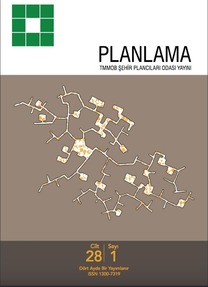Cittaslow Hareketi’ne Eleştirel Bir Bakış
Cittaslow Movement from a Critical Point of View
___
- Bott, H., Sgobba, A. ve Busch S. (2009). Slow City Concepts. Stuttgart:Universität Stuttgart Städtebau-Institut.
- Carp, J. (2012). The Town’s Abuzz: Collaborative Opportunities for Environmental Professionals in the Slow City Movement. Environmental Practice, 14, 130-142.
- Cittaslow International, www.cittaslow.org.
- Cittaslow Türkiye, https://cittaslowturkiye.org.
- Günay, Z. (2010). Neoliberal Kentleşme Dinamikleri Çerçevesinde Tarihi Çevrenin Sürdürülebilirliği: Sürdürülebilir Kentsel Koruma Modeli. (Doktora Tezi). İstanbul Teknik Üniversitesi/Fen Bilimleri Enstitüsü, İstanbul.
- Gündüz, C. (2012). Pragmatism and Utopia under the Auspices of Neoliberalism: Turning out to be Cittaslow of Seferihisar. (Doktora Tezi). Orta Doğu Teknik Üniversitesi/Sosyal Bilimler Enstitüsü, Ankara.
- Gündüz, C. (2017). Yerel Kalkınmacılıkta Cittaslow Modeli: Neoliberal Kentleşme Politikalarına Yeni Bir Alternatifsizlik mi? Tahire Erman, Serpil Özaloğlu (Ed.), Bir Varmış Bir Yokmuş: Toplumsal Bellek, Mekân ve Kimlik Üzerine Araştırmalar içinde (s.255-266). İstanbul: Koç Üniversitesi Yayınları.
- Hatipoglu, B. (2015). Cittaslow: Quality of Life and Visitor Experiences. Tourism Planning & Development, 12(1), 20-36.
- Honore, C. (2008). Yavaş. E. Gür(Çev.). İstanbul:Alfa Yayınları.
- Keskin, E.B. (2012). Sürdürülebilir Kent Kavramına Farklı Bir Bakış: Yavaş Şehirler (Cittaslow). Paradoks Ekonomi, Sosyoloji ve Politika Dergisi, 8(1), 81-99.
- Knox, P.L. ve Mayer, H. (2012). Small Town Sustainability: Economic, Social and Environmental Innovation, Basel:Birkhäuser.
- Knox, P.L. (2005). Creating Ordinary Places: Slow Cities in a Fast World. Journal of Urban Design, 10(1), 1-11.
- Lowry, L.L., Lee, M. (2011). CittaSlow, Slow Cities, Slow Food: Searching for a Model for the Development of Slow Tourism. Travel&Tourism Research Association, 42nd Annual Conference Proceedings, June 19-21, London, Ontario, Canada.
- Mayer, H. ve Knox, P.L. (2006). “Slow Cities: Sustainable Places in a Fast World”, Journal of Urban Affairs, 28(4), 321–334.
- Mayer, H., Knox, P. L. (2010). Small-Town Sustainability: Prospects in the Second Modernity. European Planning Studies, 18(10), 1545-1565.
- Mayer, H., Knox, P.L., (2009). Pace of Life and Quality of Life: The Slow City Charter. J. Sirgy, R. Phillips, D. Rahtz (Ed.), Community Quality-of-Life Indicators: Best Cases III içinde (s.21-40). Netherlands: Springer.
- Miele, M. (2008). CittàSlow: Producing Slowness against the Fast Life. Space and Polity, 12(1), 135-156.
- Milutinovic, S. (2010). CittaSlow Movement Ludlow UK. Urban Sustainable Development: A European Perspective, 1-10.
- Nilsson J.H., Svärd A.C., Widarsson A., Wirell, T. (2011). Cittáslow EcoGastronomic Heritage as a Tool for Destination Development. Current Issues in Tourism, 14(4), 373-386.
- Özmen, A. (2016). Tarihi Cittaslow Yerleşimlerinde Kentsel ve Mimari Koruma İlkeleri. (Doktora Tezi). Yıldız Teknik Üniversitesi/Fen Bilimleri Enstitüsü, İstanbul.
- Parkins W., Craig, G. (2006). Slow Living. Londra: Bloomsbury Academic.
- Parkins, W. (2004). Out of Time-Fast Subjects and Slow Living. Time and Society, 13(2/3), 363–382.
- Pink, S. (2007). Sensing Cittàslow: Slow Living and the Constitution of the Sensory City. The Senses and Society, 2(1), 59-77.
- Pink, S. (2008). Re-thinking Contemporary Activism: From Community to Emplaced Sociality. Ethnos, 73(2), 163-188.
- Pink, S. (2008). Sense and Sustainability: The Case of the Slow City Movement. Local Environment, 13(2), 95-106.
- Rådström, S.J. (2011). A Place Sustaining Framework for Local Urban Identity: an Introduction and History of Cittaslow. Italian Journal of Planning Practice, 1(1), 90-113.
- RUR, (2012). Cittaslow dall’Italia al Mondo, La Rete Internazionale delle Città del Buon Vivere. Milano: Franco Angeli.
- Taraklı Belediye Başkanı Özkaraman : “Bir An Önce Virane Evlerden Kurtulmamız Gerekiyor”. (2014, 17 Aralık). Milliyet Gazetesi.
- Telò, M. (2007). Globalization, New Regionalism and the Role of the European Union. Mario Telò (Ed.), European Union and New Regionalism Regional Actors and Global Governance in a Post-Hegemonic Era içinde (s.1-21). Hampshire, UK: Ashgate Publishing Limited.
- UCB -Uluslararası Cittaslow Birliği-, (2017). Cittaslow International Charter. Orvieto(İtalya).
- Uslu, A. (2009). Sürdürülebilir Yeşil Kent Fikirleri, Örnekleri ve Türkiye için Dersler. XXI.Uluslararası Yapı ve Yaşam Kongresi Bildiriler Kitabı, TMMOB Mimarlar Odası Yayını, Bursa.
- ISSN: 1300-7319
- Yayın Aralığı: 3
- Başlangıç: 1986
- Yayıncı: TMMOB Şehir Plancıları Odası
Ersin TÜRK, Gökhan Hüseyin ERKAN
Cittaslow Hareketi’ne Eleştirel Bir Bakış
Barış ERGEN, Muhammed özgür OĞUZ
Bir Kentsel Dönüşüm Deneyimi: Kadifekale-Uzundere İkileminde Bireysel Öyküler Üzerine Düşünmek
Elif mutlu KILIÇ, Aliye emel GÖKSU
Ali Kemal ÇINAR, Yenal AKGÜN, Hüseyin MARAL
Arazi Kullanım - Ulaşım Planlaması Bütünlüğünde Uyum İçin Model Önerisi
İstanbul’da Afet Riski Yüksek İlçelerin Planlama Açısından Değerlendirilmesi
Soylulaştırmaya Karşı Yerel Limitler: Dinamik Teori
Barış ERGEN, Muhammed Özgür OĞUZ
potekli Konut Kredilerinin Türkiye’de Finansallaşmaya Etkisi
